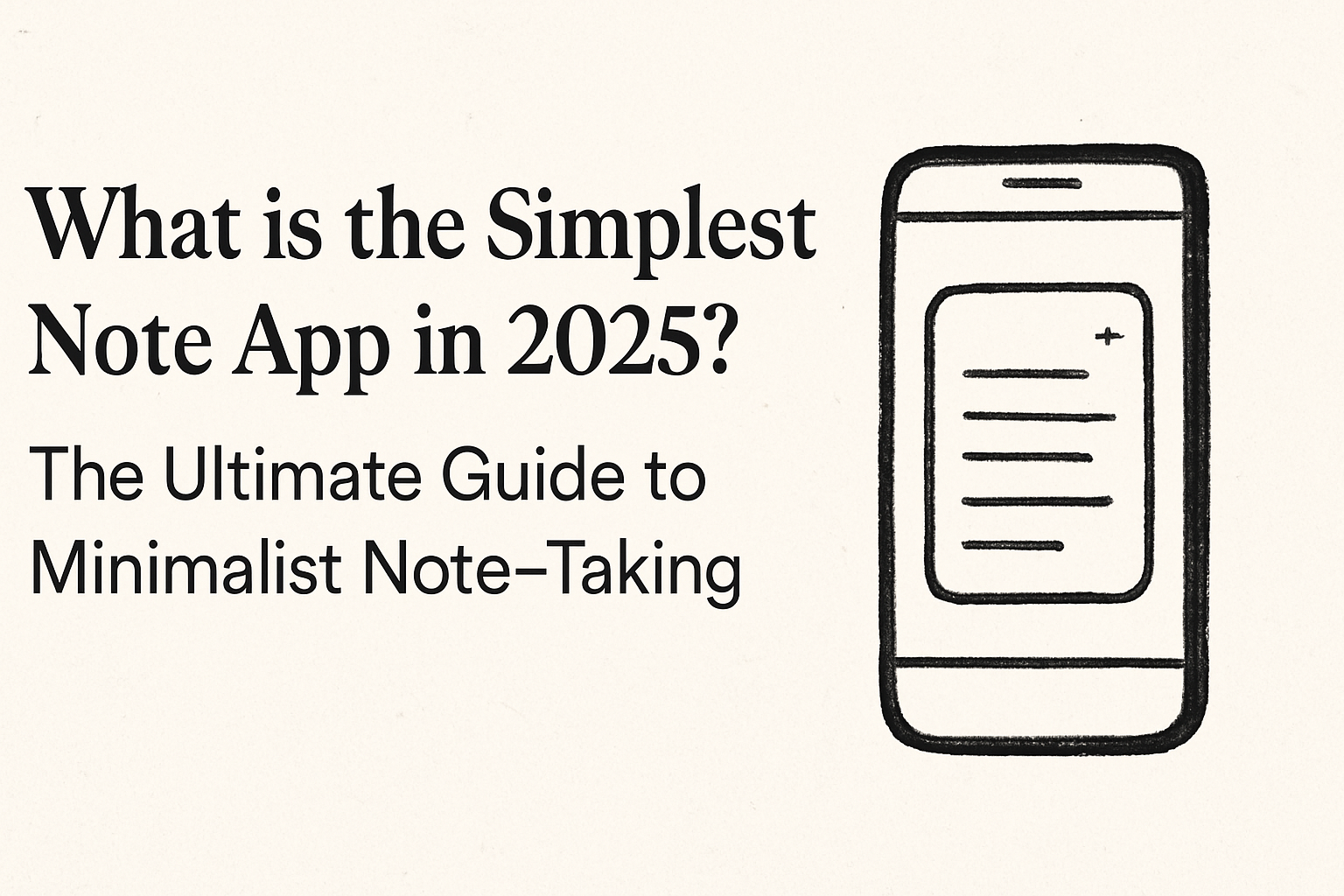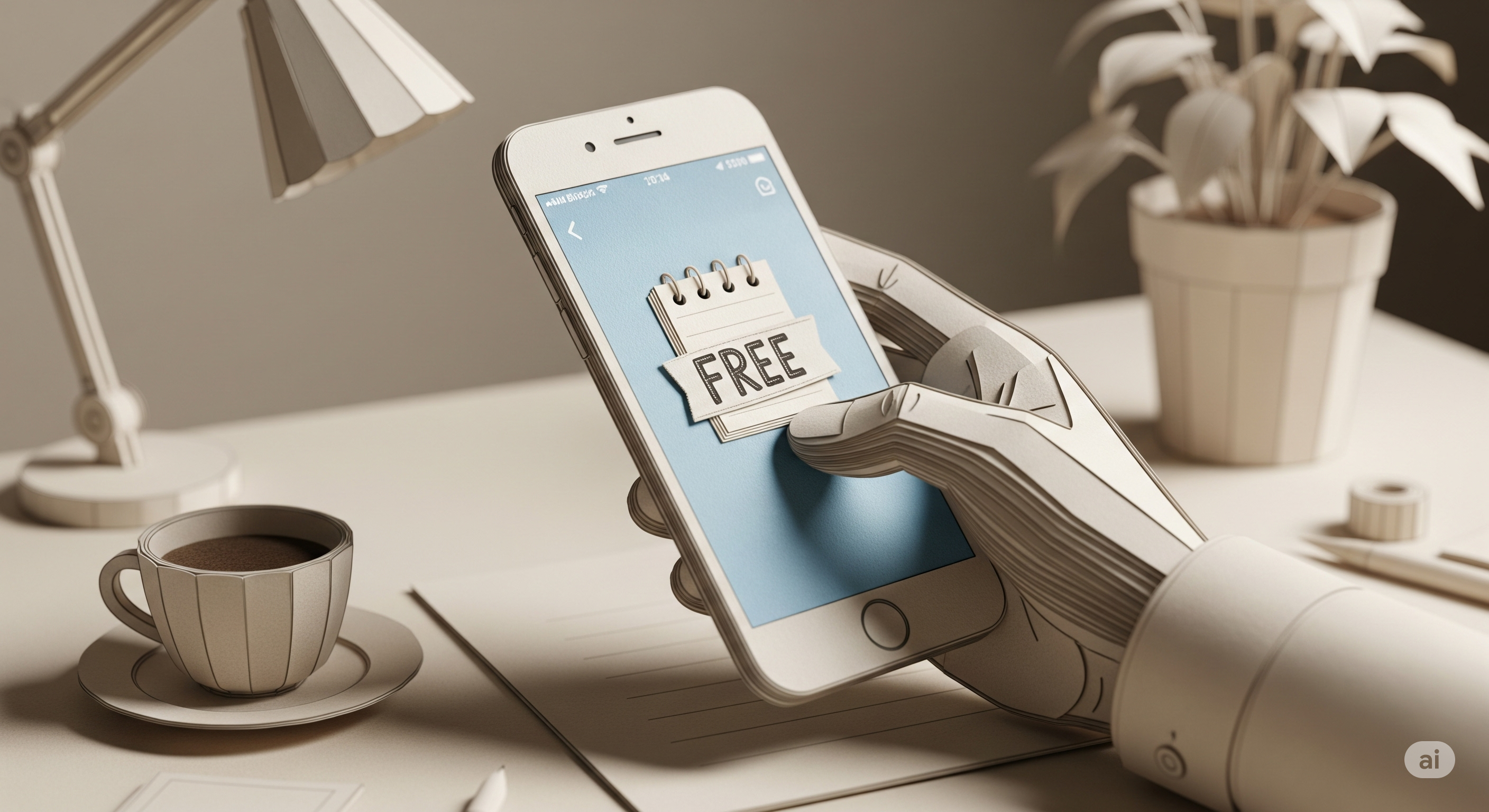What is the Simplest Note App in 2025? 9 Best Minimalist Options
Discover the 9 simplest note-taking apps of 2025 that prioritize speed, clean design, and effortless capture. Compare features, find your perfect minimalist note app, and streamline your workflow today.

What is the Simplest Note App in 2025? The Ultimate Guide to Minimalist Note-Taking
In a world where most apps try to do everything, finding a truly simple note app feels like discovering a hidden gem. You know the frustration: opening a note-taking app only to be bombarded with menus, widgets, and features you'll never touch. What you really want is something that gets out of your way and lets you capture thoughts instantly.
The best simple note apps share one core philosophy: they prioritize your ideas over their features. With the global note-taking app market exploding from $7.91 billion in 2024 to a projected $26.66 billion by 2032, there's clearly massive demand for these tools. Yet amid this growth, the simplest solutions often shine brightest.
This comprehensive guide cuts through the noise to reveal the 9 most genuinely simple note apps available in 2025. Whether you're a student, professional, or someone who just wants to jot down thoughts without friction, you'll find your perfect match here.
The 5 Non-Negotiable Elements of Truly Simple Note Apps
Before diving into specific apps, let's establish what "simple" actually means. After analyzing dozens of note-taking tools and reviewing user feedback patterns, five key characteristics consistently separate truly simple apps from the rest:
1. Zero-Friction Interface Design
The best simple note apps feel invisible. When you open them, there's no cognitive load—just a clean space for your thoughts. Academic research in Human-Computer Interaction confirms that minimalist interfaces reduce mental processing time by up to 40%, letting you focus purely on content creation.
2. Lightning-Fast Performance
Simple apps prioritize speed above all else. They launch in under 2 seconds, sync notes instantly across devices, and never lag during typing. This responsiveness creates a seamless flow from thought to digital capture.
3. Core Functionality Only
These apps deliberately limit features to essentials: text capture, basic formatting (bold, italics, lists), simple organization, and reliable search. They resist feature creep that complicates the user experience.
4. Intuitive From First Use
You shouldn't need tutorials, onboarding sequences, or help documentation. The best simple apps are self-explanatory—open them and start typing immediately.
5. Universal Accessibility
Your notes should be available wherever you are. Simple apps offer cross-platform compatibility and reliable cloud syncing without complicated setup procedures.
The 9 Simplest Note Apps of 2025: Our Complete Breakdown
After extensive testing and user research, here are the genuinely simplest note-taking solutions available today, organized by their primary strengths:
For Pure Text Capture: The Minimalist Champions
1. Simplenote: The Gold Standard of Simple
Simplenote lives up to its name with ruthless simplicity. This app strips note-taking down to its essence: fast text capture with zero distractions. What makes it exceptional?
- Instant sync across all devices without setup hassles
- Markdown support for users who want light formatting
- Powerful search that finds notes instantly
- Tag-based organization that stays out of your way
- Completely free with no ads or premium tiers
Tech publication Cloudwards consistently ranks Simplenote as the top choice for users who prioritize pure text focus. The app's interface is so clean that new users often wonder if it's fully loaded—that's exactly the point.
2. Built-in OS Notes: Already in Your Pocket
Your device came with a note app for good reason. Apple Notes, Google Keep, and Windows Sticky Notes offer immediate access without downloading anything new.
Apple Notes has evolved into a surprisingly capable yet simple tool. Its clean interface, seamless iCloud sync, and integration with Siri make it perfect for iOS users who want zero-friction note capture.
Windows Notepad remains the ultimate in desktop simplicity—just text, nothing else. For basic text files and quick jots, nothing beats its instant launch and universal compatibility.
For Quick Capture & Visual Organization
3. Google Keep: Cards That Make Sense
Google Keep transforms note-taking into an intuitive card-based system. Each note becomes a colorful card that you can quickly scan, edit, and organize. This visual approach makes it exceptionally simple for:
- Shopping lists with checkable items
- Quick reminders with location and time triggers
- Voice notes that automatically transcribe to text
- Photo notes with OCR text extraction
Cloudwards highlights Keep's strength in visual organization and seamless Google ecosystem integration. The app's widget system also provides home screen access for instant note capture.
4. Note.new: Instant Browser Notes
Sometimes you need to capture something right now without opening apps or signing into accounts. Note.new provides an instant, blank canvas in your browser—just type the URL and start writing.
Perfect for temporary notes, quick calculations, or when you're on someone else's computer. Your notes auto-save locally and can be shared via simple links.
For Visual Thinkers
5. Xtiles: Simple Yet Structured
Xtiles brings visual simplicity to structured thinking. Its drag-and-drop tile interface makes organizing thoughts feel natural without overwhelming complexity.
Key advantages include:
- Visual tile organization that's immediately intuitive
- Offline access for notes anywhere
- Clean, distraction-free design
- Light project planning capabilities without feature bloat
The Business Dive recognizes Xtiles for balancing visual appeal with genuine simplicity—a rare combination in today's app landscape.
For Flexible, Freeform Capture
6. Microsoft OneNote: Simple Despite Its Power
OneNote might seem like an odd choice for "simple," but its freeform canvas approach creates an intuitive note-taking experience. You can click anywhere on the page and start typing, drawing, or inserting content—just like a physical notebook.
What keeps it simple:
- No rigid structure—organize notes however feels natural
- Excellent handwriting recognition for tablet users
- Seamless multimedia integration without complexity
- Powerful search across all content types
Zapier recommends OneNote as the best versatile free option, praising its ability to handle diverse content types while maintaining ease of use.
For Markdown Lovers Seeking Simplicity
7. Typora: Markdown Made Visual
If you appreciate Markdown's structure but want a clean writing environment, Typora offers the perfect balance. Its "what you see is what you get" approach eliminates the typical Markdown preview/edit split.
Why it's genuinely simple:
- Live preview eliminates interface switching
- Distraction-free writing mode
- Focus mode that highlights only your current paragraph
- Clean export options to multiple formats
8. Obsidian: Simple When You Want It
While Obsidian can become incredibly complex, it excels as a simple, local-first Markdown editor. For basic use cases, it offers straightforward organization with the security of knowing your notes live on your device as plain text files.
Simple Obsidian advantages:
- Local storage—your notes, your control
- Plain text files that work with any app
- Fast, responsive interface
- Powerful linking between notes
TechRadar notes that Obsidian serves users across the entire complexity spectrum, making it perfect for those who want to start simple with room to grow.
Beyond Apps: The Simplest Solutions
9. Pen and Paper: The Original Simple Solution
Sometimes the simplest solution isn't digital at all. Handwritten notes offer unique cognitive benefits that apps can't replicate:
- 20% better memory retention compared to typed notes
- 5-10% more information retention according to research studies
- 40% increase in active engagement with the material
- Zero battery requirements or technical failures
For many users, a simple notebook and pen remains the fastest, most reliable capture method available.
Quick Comparison: Find Your Perfect Match
| App | Best For | Key Strength | Platforms | Price |
|---|---|---|---|---|
| Simplenote | Pure text capture | Ultimate minimalism | All platforms | Free |
| Google Keep | Quick notes & lists | Visual card system | iOS, Android, Web | Free |
| Xtiles | Visual organization | Intuitive tile interface | Web, Desktop | Freemium |
| OneNote | Freeform capture | Digital canvas flexibility | All platforms | Free |
| Obsidian | Local Markdown notes | Privacy & plain text | All platforms | Free personal use |
| Typora | Markdown writing | Live preview editing | Desktop only | One-time purchase |
How to Choose Your Ideal Simple Note App
The perfect simple note app depends on your specific workflow. Ask yourself these key questions:
Consider Your Primary Use Case
- Quick thoughts? → Google Keep or built-in OS apps
- Long-form writing? → Simplenote or Typora
- Visual organization? → Xtiles or OneNote
- Privacy-focused? → Obsidian or local text files
Evaluate Your Device Ecosystem
- All Apple devices? → Apple Notes offers seamless integration
- Mixed platforms? → Simplenote or OneNote sync everywhere
- Primarily desktop? → Typora or Obsidian excel here
- Mobile-first? → Google Keep is hard to beat
Determine Your Simplicity Threshold
- Absolute minimalism? → Simplenote or plain text editors
- Simple with some structure? → Google Keep or Xtiles
- Flexible simplicity? → OneNote or basic Obsidian use
Start With Our Top Pick: Simplenote
The Future of Simple Note-Taking
As we move through 2025, even simple note apps are getting smarter without becoming more complex. Key trends include:
- AI-powered search that understands context, not just keywords
- Smart auto-tagging that organizes notes without manual effort
- Voice-to-text improvements with 99%+ accuracy rates
- Cross-app integration that maintains simplicity while adding utility
The best simple apps will incorporate these advances while preserving their core philosophy: getting out of your way so you can focus on your thoughts.
Your Next Step: Choose and Commit
The simplest note app is ultimately the one you'll actually use consistently. Don't get caught in endless comparison—pick one that matches your primary needs and commit to it for at least two weeks. You'll quickly discover whether it fits your workflow.
Remember: the goal isn't finding the perfect app; it's finding one that disappears into the background while reliably capturing your thoughts. Whether that's the elegant minimalism of Simplenote, the visual clarity of Google Keep, or the timeless simplicity of pen and paper, the best choice is the one that serves your mind, not the other way around.
Try Google Keep Explore Xtiles
Expert Sources & Further Reading
This guide draws from extensive research across tech publications, user studies, and hands-on testing. For deeper insights into note-taking effectiveness and app comparisons, explore these authoritative sources:
| Resource Type | Source & Link | Key Insights |
|---|---|---|
| 2025 App Reviews | The Business Dive: Best Note-Taking Apps for 2025 | Current market analysis, Xtiles review, UI/UX trends |
| Minimalist App Analysis | Cloudwards: Best Note-Taking Apps in 2025 | Simplenote deep-dive, Google Keep features, simplicity metrics |
| Free App Comparison | Zapier: The 6 Best Note Taking Apps in 2025 | OneNote analysis, cross-platform functionality, workflow integration |
| Comprehensive Reviews | TechRadar: Best Note-Taking App of 2025 | Feature complexity analysis, Obsidian versatility, user experience studies |
| Academic Research | Google Scholar: "digital note-taking cognitive load" & "minimalist interface usability" | Scientific backing for simplicity benefits, handwriting vs typing studies |




